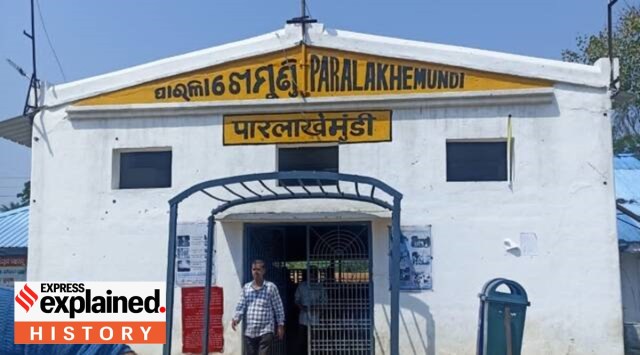However, there are concerns that the 124-year-old station might be demolished to pave way for new structures. Experts have raised red flags and sought heritage status for the structure.

We tell the story of the railway station and the historic railway line that passed through it.
Paralakhemundi Light Railway (PLR)
Naupada (a small town, now in Andhra Pradesh) got rail lines in 1894, as part of construction of Cuttack-Khurda Road railway line extending up to Vijayawada.
The then Maharaja of Parlakimedi (now Paralakhemundi) Goura Chandra Gajapati Narayan Deo II conceived of an idea to connect his capital with this mainline in an effort to strengthen his communication network. After receiving nod of the British authorities in 1898, he built a 39-km rail line— PLR — by spending around Rs 7 lakh from the royal coffers.
The 2-ft and 6 inches narrow gauge line was completed in 1899 and opened for traffic in 1900.
According to Dilip Samantray’s Odisha: The Railway Story, most of the coaches and wagons for PLR trains were supplied by Arthur Koppel and Co. of Calcutta, who assembled them from the kits supplies by a Germany-based company. The locomotives were built by England-based Kerr, Stuart and Company.
Story continues below this ad
A wooden-bodied carriage was also built in 1899, for the specific use of the royal family of Paralakhemundi.
Takeover by Bengal-Nagpur Railway and further expansion
In January 1902, with the British government changing its policy, the Bengal-Nagpur Railway (BNR) took over PLR along with operational charge of railway operations between Vizianagaram (now in Andhra Pradesh) to Cuttack.
According to BM Adhikari, a local researcher, although the PLR had incurred initial losses, it started gradually started to make profits after 1910. The profit from the line encouraged Krushna Chandra Gajapati, the successor of the Paralakhemundi estate, to take up further expansion of the line up to Gunupur, the southern part of the state, by 1930.
The Paralakhemundi Royal Estate
Paralakhemundi Royal Estate was the largest estate in the Ganjam district of the Madras Presidency. It is believed that the kings of Paralakhemundi are the descendants of Gajapati kings of Odisha’s Eastern Ganga dynasty. Apart from railway lines, the Paralakhemundi royals also took up several other development measures in the fields of education, irrigation and roads, among others.
Recent developments and INTACH’s demand
Story continues below this ad
In 2011, the Railway Ministry had sanctioned a plan to upgrade the 90 km Naupada-Gunupur via Paralakhemundi narrow gauge line to a broad gauge, which would allow for the operation of more trains on the route and facilitate hassle-free traffic.
It would also develop a new station building on a raised platform, for the benefit of the passengers and carried out safety-related modernisation works including building an electronic interlocking system at the station.
However, the Indian National Trust for Art and Cultural Heritage (INTACH), a non-profit working on heritage conservation and awareness, has argued for the old structure to be preserved. According to INTACH, the structure is in good shape and does not need any further work which would undermine its tremendous historical value.
Thus, it has demanded the railway station’s preservation as a heritage building, along with the restoration of other ancillary buildings like the old station master’s building which INTACH wants to convert into a museum.
Story continues below this ad
INTACH has also strongly demanded to bring back all other artefacts relating to the PLR to Paralakhemundi, many of which — such as signalling equipment, electrical equipment, scales, uniforms, insignia, German silver cutlery and erstwhile royal embellishments — are currently kept in the Nagpur museum.








































